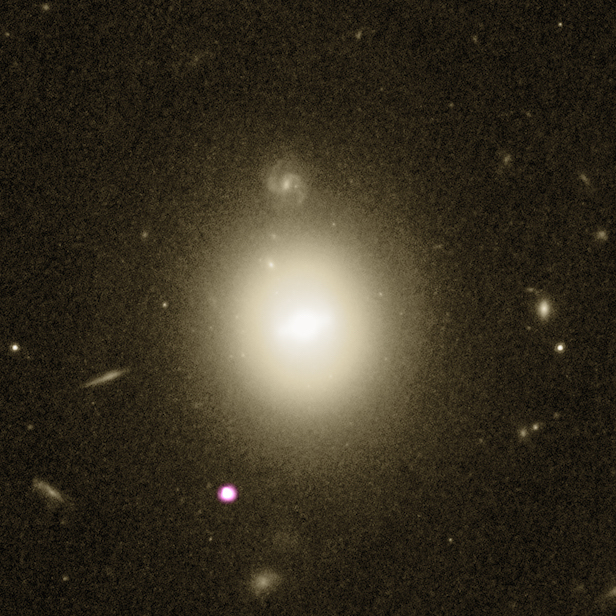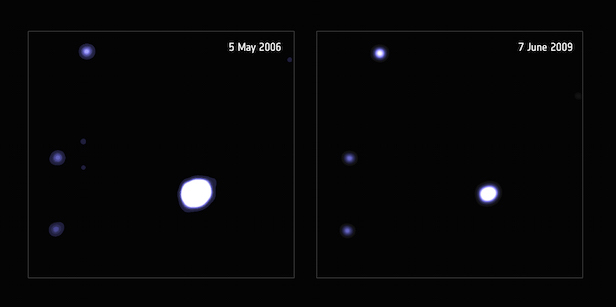Rare black hole seen shredding a star
This kind of event has only been clearly seen at the centre of a galaxy before, not at the outer edges

Best ever intermediate-mass black hole candidate. Image credit: Optical: NASA/ESA/Hubble/STScI; X-ray: NASA/CXC/UNH/D. Lin et al.
The European Space Agency (ESA)’s XMM-Newton observatory has discovered the best-ever candidate for a very rare and elusive type of cosmic phenomenon: a medium-weight black hole in the process of tearing apart and feasting on a nearby star.
There are various types of black hole lurking throughout the universe: massive stars create stellar-mass black holes when they die, while galaxies host supermassive black holes at their centres, with masses equivalent to millions or billions of Suns.
Lying between these extremes is a more retiring member of the black hole family: intermediate-mass black holes (IMBH). Thought to be seeds that will eventually grow to become supermassive, these black holes are especially elusive, and thus very few robust candidates have ever been found.
Now, a team of researchers using data from ESA’s XMM-Newton X-ray space observatory, as well as NASA’s Chandra X-Ray Observatory and Swift X-Ray Telescope, has found a rare telltale sign of activity. They detected an enormous flare of radiation in the outskirts of a distant galaxy, thrown off as a star passed too close to a black hole and was subsequently devoured. (The galaxy is named 6dFGS gJ215022.2-055059, while the X-ray source inferred to contain the IMBH is named 3XMM J215022.4-055108.)
“This is incredibly exciting: this type of black hole hasn’t been spotted so clearly before,” says lead scientist Dacheng Lin of the University of New Hampshire, USA. “A few candidates have been found, but on the whole they’re extremely rare and very sought after. This is the best intermediate-mass black hole candidate observed so far.”
This breed of black hole is thought to form in various ways. One formation scenario is the runaway merger of massive stars lying within dense star clusters, making the centres of these clusters one of the best places to hunt for them. However, by the time such black holes have formed, these sites tend to be devoid of gas, leaving the black holes with no material to consume and thus little radiation to emit – which in turn makes them extremely difficult to spot.
“One of the few methods we can use to try to find an intermediate-mass black hole is to wait for a star to pass close to it and become disrupted – this essentially ‘activates’ the black hole’s appetite again and prompts it to emit a flare that we can observe,” adds Lin.

XMM-Newton view of intermediate-mass black hole candidate. Image credit: ESA/XMM-Newton; D. Lin et al (University of New Hampshire, USA). Acknowledgement: NASA/CXC
“This kind of event has only been clearly seen at the centre of a galaxy before, not at the outer edges.”
Lin and colleagues sifted through data from XMM-Newton to find the candidate. They identified it in observations of a large galaxy some 740 million light-years away, taken in 2006 and 2009 as part of a galaxy survey, and in additional data from Chandra (2006 and 2016) and Swift (2014).
“We also looked at images of the galaxy taken by a whole host of other telescopes, to see what the emission looked like optically,” says co-author Jay Strader of Michigan State University, USA.
“We spotted the source flaring in brightness in two images from 2005 — it appeared far bluer and brighter than it had just a few years previously. By comparing all the data we determined that the unfortunate star was likely disrupted in October 2003 in our time, and produced a burst of energy that decayed over the following 10 years or so.”
The scientists believe that the star was disrupted and torn apart by a black hole with a mass of around fifty thousand times that of the Sun.
Such star-triggered outbursts are expected to only happen rarely from this type of black hole, so this discovery suggests that there could be many more lurking in a dormant state in galaxy peripheries across the local universe.
“This candidate was discovered via an intensive search of XMM-Newton’s X-ray Source Catalogue, which is filled with high-quality data covering large areas of sky, essential for determining how large the black hole was and what happened to cause the observed burst of radiation,” says Norbert Schartel, ESA Project Scientist for XMM-Newton.
“The XMM-Newton X-ray Source Catalogue is presently the largest catalogue of this type, containing more than half a million sources: exotic objects like the one discovered in our study are still hidden there and waiting to be discovered through intensive data mining,” adds co-scientist Natalie Webb, director of the XMM-Newton Survey Science Center at the Research Institute in Astrophysics and Planetology (IRAP) in Toulouse, France.
“Learning more about these objects and associated phenomena is key to our understanding of black holes. Our models are currently akin to a scenario in which an alien civilisation observes Earth and spots grandparents dropping their grandchildren at pre-school: they might assume that there’s something intermediate to fit their model of a human lifespan, but without observing that link, there’s no way to know for sure. This finding is incredibly important, and shows that the discovery method employed here is a good one to use,” concludes Norbert.
Keep up to date with the latest reviews in All About Space – available every month for just £4.99. Alternatively you can subscribe here for a fraction of the price!





